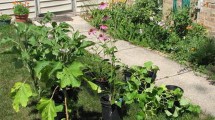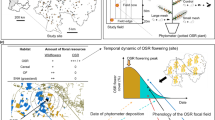Abstract
Urban agriculture can increase the sustainability of cities by reducing their ecological footprint, conserving biodiversity, and improving quality of life in a city. Given the environmental, economic and social value of urban agriculture, it is important to understand the ecosystem services that sustain it. We experimentally investigated how pollination by wild bees affects tomato production on 16 urban agriculture sites in San Francisco, CA. By comparing four pollination service indicators (fruit set, fruit mass, yield, and seed set) in four pollination treatments (open, artificial-self, artificial-cross, control), we were able to determine that tomatoes pollinated by wild bees significantly outperform the control in terms of all four pollination service indicators measured. Furthermore, the results of this study indicate that urban areas can support adequate pollination service to urban agriculture, regardless of garden size, garden age, or proportion of impervious surface in the surrounding matrix, and that floral resource density is a major factor influencing pollination service.


Similar content being viewed by others
References
Ahrné K, Bengtsson J, Elmqvist T (2009) Bumble bees (Bombus spp) along a gradient of increasing urbanization. PLoS One 4(5):e5574
Alliance SAFE (1994) The food miles report: the dangers of long distance food transport. SAFE Alliance, London
Armar-Klemesu M (2000) Urban agriculture and food security, nutrition and health. In: Bakker N, Dubbeling M, Gundel S, Sabel-Koschella U, de Zeeuw H (eds) Growing cities, growing food: urban agriculture on the policy agenda. GTZ/DSE, Germany
Buchmann SL (1983) Buzz pollination in angiosperms. In: Jones CE, Little RJ (eds) Handbook of experimental pollination biology. Van Nostrand Reinhold, New York, pp 73–133
Buchmann SL, Nabhan GP (1996) The forgotten pollinators. D.C., Island Press, Washington
Charles WB, Harris RE (1972) Tomato fruit-set at high and low temperatures. Can J Plant Sci 52:497–506
Frankie GW et al (2005) Ecological patterns of bees and their host ornamental flowers in two northern California cities. J Kansas Entomol Soc 78(3):227–46
Free JB (1963) The flower constancy of honeybees. J Anim Ecol 32:119–131
Free JB (1993) Insect pollination of crops, 2nd edn. Academic, San Diego
Gathmann A, Tscharntke T (2002) Foraging ranges of solitary bees. J Anim Ecol 71:757–764
Greenleaf SS, Kremen C (2006) Wild bee species increase tomato production and respond differently to surrounding land use in Northern California. Biol Conserv 133:81–87
Greenleaf SS, Williams NM, Winfree R, Kremen C (2007) Bee foraging ranges and their relationship to body size. Oecologia 153:589–596
Higo HA, Rice ND, Winston ML, Lewis B (2004) Honey bee (Hymenoptera: Apidae) distribution and potential for supplementary pollination in commercial tomato greenhouses during winter. J Econ Entomol 97:163–170
Ho LC, Hewitt JD (1986) Fruit development. In: Atherton JG, Rudich J (eds) The tomato crop. Chapman and Hall, London, pp 201–40
Kearns CA, Inouye DW (1993) Techniques for pollination biologists. University Press of Colorado, Niwot
Kearns CA, Oliveras DM (2009) Environmental factors affecting bee diversity in urban and remote grassland plots in Boulder, Colorado. J Insect Conserv 13:655–665
Kilkenny FF, Galloway LF (2008) Reproductive success in varying light environments: direct and indirect effects of light on plants and pollinators. Oecologia 155:247–255
King MJ, Buchmann SL (2003) Floral sonication by bees: mesosomal vibration by Bombus and Xylocopa, but not Apis (Hymenoptera: Apidae), ejects pollen from poricidal anthers. J Kansas Entomol Soc 76:295–305
Klein AM et al (2007) Importance of pollinators in changing landscapes for world crops. Proc R Soc Lon B Biol Sci 274:303–313
Kremen C, Williams NM, Thorp RW (2002) Crop pollination from native bees at risk from agricultural intensification. Proc Natl Acad Sci U S A 99:16812–16816
Lawson LJ (2005) City bountiful: a century of community gardening in America. University of California Press, Berkeley
Matteson K, Langellotto G (2009) Bumble bee abundance in New York City community gardens: implications for urban agriculture. Cities Environ 2(1) Art. No.-5
Matteson K, Langellotto G (2010) Determinates of inner city butterfly and bee species richness. Urban Ecosystems 13:333–347, published on line
Matteson K et al (2008) Bee richness and abundance in New York City urban gardens. Ann Entomol Soc Am 101(1):140–150
McFrederick Q, LeBuhn G (2004) Are urban parks refuges for bumblebees? Biol Conserv 129:372–382
Morandin LA, Laverty TM, Kevan PG (2001) Effect of bumble bee (Hymenoptera: Apidae). J Econ Entomol 94(2):462–467
Mougeot LJA (1994) Urban food production: evolution, official support and significance. International Development Research Centre, Cities Feeding People Series, Environment and Natural Resources Division, Ottawa
Potts SG, Vulliamy B, Dafni A, Ne’eman G, Willmer P (2003) Linking bees and flowers: how do floral communities structure pollinator communities? Ecology 84(10):2628–2642
Smit J, Ratta A, Nasr J (2001) Urban agriculture: food, jobs and sustainable cities. Publication series for habitat II, vol 1. United Nations Development Program, New York
Smith RM, Warren PH, Thompson K, Gaston KJ (2006) Urban domestic gardens (VI): environmental correlates of invertebrate species richness. Biodivers Conserv 15:2415–2438
van Delft Y, McDonald F (eds) (1998) The ecological footprint of cities. The International Institute for the Urban Environment, Delft
van Veenhuizen R (2000) Cities farming for the future, urban agriculture for green and productive cities. RUAF Foundation, IDRC and IIRR, Phillipines
Wackernagel M, Rees W (1996) Our ecological footprint: reducing human impact on the earth. New Society Publishers, Philadelphia
Acknowledgments
This study was supported by the NSF TREE Fellowship. We thank E. Connor, and V.T. Parker. We also thank ECOSF School Farm, San Francisco Bee-Cause, and all the land managers and gardeners who volunteered their time and land.
Author information
Authors and Affiliations
Corresponding author
Rights and permissions
About this article
Cite this article
Potter, A., LeBuhn, G. Pollination service to urban agriculture in San Francisco, CA. Urban Ecosyst 18, 885–893 (2015). https://doi.org/10.1007/s11252-015-0435-y
Published:
Issue Date:
DOI: https://doi.org/10.1007/s11252-015-0435-y




